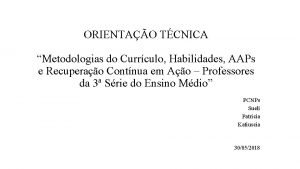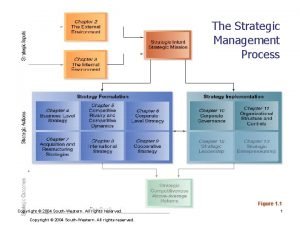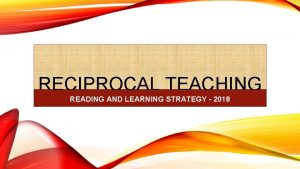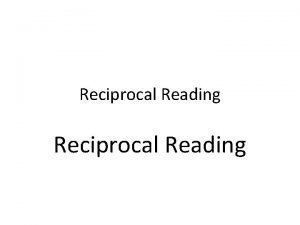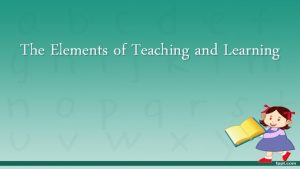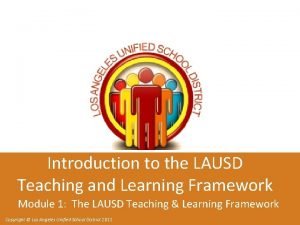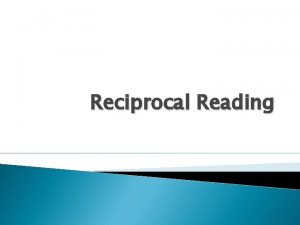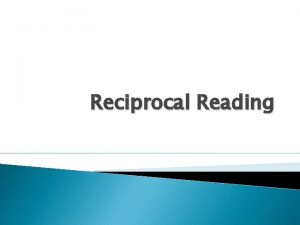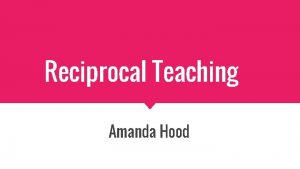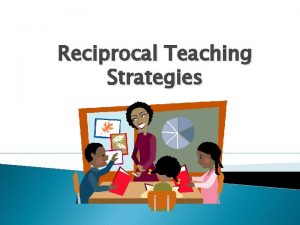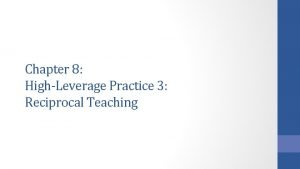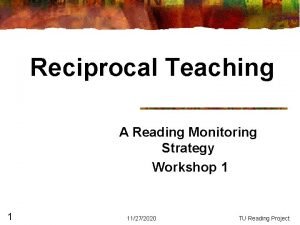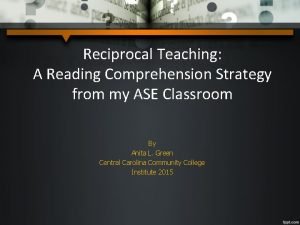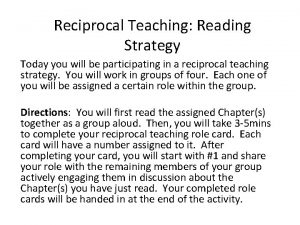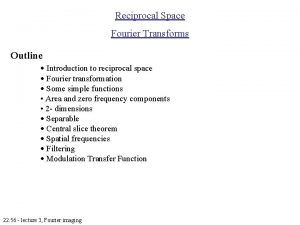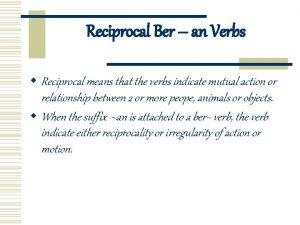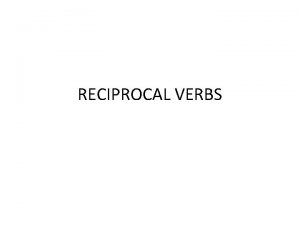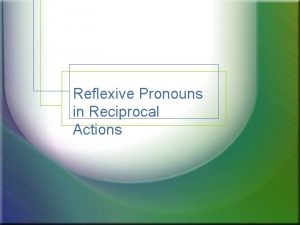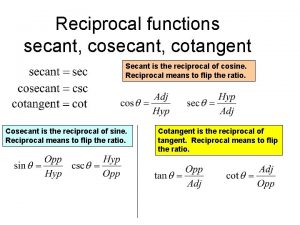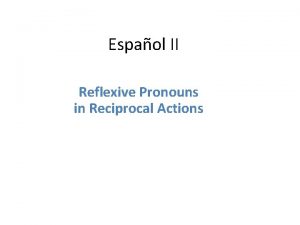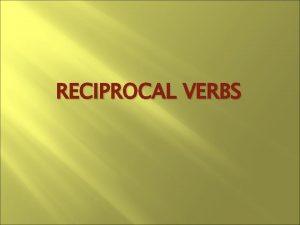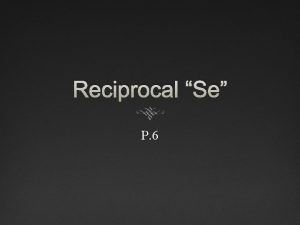RECIPROCAL TEACHING READING AND LEARNING STRATEGY 2018 PROFESSOR




















- Slides: 20

RECIPROCAL TEACHING READING AND LEARNING STRATEGY - 2018

PROFESSOR JOHN HATTIE …is a researcher in education. His research interests include performance indicators, models of measurement and evaluation of teaching and learning. John Hattie became known to a wider public with his two books Visible Learning and Visible Learning for teachers. Visible Learning is a synthesis of more than 800 meta-studies covering more than 80 milion students. According to John Hattie Visible Learning is the result of 15 years of research about what works best for learning in schools. TES once called him “possibly the world’s most influential education academic”.

PROFESSOR JOHN HATTIE John Hattie has been Director of the Melbourne Educational Research Institute at the University of Melbourne, Australia, since March 2011. Before, he was Project Director of as. TTle and Professor of Education at the University of Auckland, New Zealand. He holds a Ph. D from the University of Toronto, Canada. You can find a full CV of Professor John Hattie (PDF) at the website of the University of Auckland.

ABOUT VISIBLE LEARNING Visible Learning means an enhanced role for teachers as they become evaluators of their own teaching. Visible Teaching and Learning occurs when teachers see learning through the eyes of students and help them become their own teachers.

VISIBLE LEARNING PLUS Visible Learning plus is a professional development program for teachers. It provides an in-depth review and change model for schools based on John Hattie's research. With a seminar and support series the Visible Learning plus team helps schools to find out about the impact they are having on student achievement. www. visiblelearningplus. com


RECIPROCAL TEACHING …IS A GUIDED READING COMPREHENSION STRATEGY THAT ENCOURAGES STUDENTS TO DEVELOP THE SKILLS THAT EFFECTIVE READERS & LEARNERS DO AUTOMATICALLY: summarise, question, clarify, predict and respond to what they are reading. STUDENTS USE THESE FOUR STRATEGIES ON A COMMON TEXT, IN PAIRS OR SMALL GROUPS. RT – can be used with fiction, non-fiction, prose or poetry. THERE ARE 5 STEPS…

STEP 1 The teacher reads a section of the text aloud and models the four steps – summarising, clarifying, questioning and predicting. STEP 2 In groups of four allocate a role to each student i. e. summariser, questioner, clarifier and predictor. STEP 3 Have students read x paragraph of a text. Suggest to students they use notetaking strategies such as underlining, coding, etc.

STEP 4 The predictor helps the group connect sections of the text and helps the group predict what they will read about next by using clues and inferences in the text. The questioner helps the group to ask and answer questions about the text and reminds the group to use all types of questions (higher and lower order). The summariser restates the main ideas in the text and helps the group state the main idea or ideas in their own words. The clarifier helps the group find parts of the reading that are not clear and finds ways to clear up these difficulties. STEP 5 Roles in the group switch and the next selection of the text is read. Students repeat the process in their new role. Repeat this process until text/topic selection is finished.

RECIPROCAL TEACHING IN SHORT… § In groups students will read and discuss a text. § Each student takes a different role. § Each student keeps his or her job for the entire reciprocal teaching discussion. § Jobs can be rotated with each new piece of text. Continue to guide the students in the use of the four strategies until they can use the strategy independently.

STRATEGY ACTIVITY Predictor: predicts with evidence • My prediction is… Questioner: poses questions for the group to discuss • My evidence is… • My on-the-surface question is… Other students agree or disagree and give evidence. Other students answer the questions. • My under-the-surface question is…

STRATEGY ACTIVITY Clarify Summarise Clarifier: asks for or gives clarification Summariser: summarises • I need to have _____ clarified. • I think the most important idea/s are… • Do you need anything clarified? • My summary is… Students talk about parts that were confusing and discuss unknown words. Other students add to the summary.

Reciprocal Teaching Role Cards The Questioner Ask questions which will help the group to understand what has been read. Think of questions to ask as you read the text ……. . What is? How did? Who/What would? What will? Why is? What can? Where / When How is? When can? would? will? Which What did? Why can? Which would? will? Why did? How can? Why would? Who will? How would? What might?

Reciprocal Teaching Role Cards The Summariser Tell the group what you have read in your own words. Have the group pick out the main ideas. The most important ideas are … The main idea is … This part was about … First, . . Next, …. Then, … This story takes place in … The main events of … The problem is …

Reciprocal Teaching Role Cards The Predicator Use what you have read and the text features to help figure out what the group will learn and/or what will happen in the next piece of text. The group can change their predictions as they read on! I think … I wonder if … I imagine … I suppose … I predict … I think the next section will be about…

Reciprocal Teaching Role Cards The Clarifier You must clarify when: • The group is confused by what they have read. • When a word is read and not understood. • When a sentence is read that doesn’t make sense. • When a question is asked. • Think about what you did to help you understand tell the group. (E. g. Reread the sentence looking for clues to help you figure out the word or phrase; Break the word apart and look for smaller words you already know; Look for a prefix or suffix; Look at the text features).

predictor You will tell the group what you think you will read about next. What is the writer/text going to say now? Preview the section and think about the main ideas (look at text features, chapter questions, etc. ). Consider topics you think will be covered and key vocabulary you might expect to come across. Share your predictions first and then encourage all group members to add their predictions with reasons for them.

questioner You will ask two questions about the reading. One is an on-the-surface question - who, what, when, or where. The other is an under-the-surface question - why, how, should, could, or would. Work with the group to decide where the answer to these questions might be-in the reading, in the clues, in another source, or in the reader’s mind. Make sure the group attempts to answer the questions.

clarifier You will first ask the group to help you clarify any words or ideas that you did not understand. You will then ask anyone in the group if they need any words or ideas clarified. Work with the group to determine meanings of unknown vocabulary or unclear ideas. Make sure the group feels comfortable asking for clarification.

summariser You will write a summary of the most important information from the reading. You need to be able to explain the reading in two or three sentences. Think about the main idea/s and the most important details. Use the text features e. g. headings, bold print, etc. to help you create a strong summary. Think like the author and try to figure out what s/he wanted to tell you. The group can help you if you get stuck or if they think you forgot something.
 Pre reading while reading and post reading activities
Pre reading while reading and post reading activities Promotion from assistant to associate professor
Promotion from assistant to associate professor Aap 2018 um professor ministra um curso especial
Aap 2018 um professor ministra um curso especial Functional structure
Functional structure Reciprocal teaching video
Reciprocal teaching video Reciprocal teaching role cards
Reciprocal teaching role cards 7 reciprocal teaching steps
7 reciprocal teaching steps Que letra continua m v t m j
Que letra continua m v t m j Professor hill's strategy development framework
Professor hill's strategy development framework Differences between micro teaching and traditional teaching
Differences between micro teaching and traditional teaching Cuadro comparativo de e-learning b-learning y m-learning
Cuadro comparativo de e-learning b-learning y m-learning Reading aims
Reading aims 2 types of reading
2 types of reading Intensive reading and extensive reading
Intensive reading and extensive reading For adult
For adult Characteristics of intensive reading
Characteristics of intensive reading Appetitive faculties of a learner
Appetitive faculties of a learner New jersey center for teaching and learning
New jersey center for teaching and learning New jersey center for teaching and learning
New jersey center for teaching and learning End goals of mtb-mle
End goals of mtb-mle Lausd teacher framework
Lausd teacher framework


